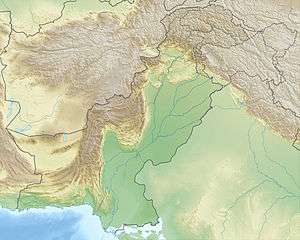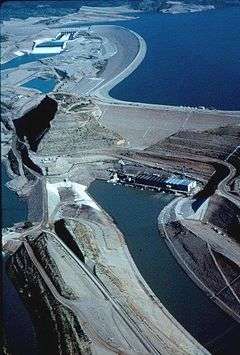Diamer-Bhasha Dam
| Diamer-Bhasha Dam | |
|---|---|
 Location of Diamer-Bhasha Dam in Pakistan | |
| Country | Pakistan |
| Location | Gilgit-Baltistan |
| Coordinates | 35°32′30.64″N 73°36′25.98″E / 35.5418444°N 73.6072167°ECoordinates: 35°32′30.64″N 73°36′25.98″E / 35.5418444°N 73.6072167°E |
| Status | Preliminary construction |
| Construction began | 18 October 2011 |
| Opening date | 2020 (est.) |
| Construction cost | $14 billion (2013 est.)[1] |
| Owner(s) | WAPDA |
| Dam and spillways | |
| Type of dam | Gravity, roller-compacted concrete |
| Impounds | Indus River |
| Height | 272 m (892 ft) |
| Reservoir | |
| Total capacity | 10,000,000,000 m3 (8,107,132 acre·ft) |
| Active capacity | 7,900,000,000 m3 (6,404,634 acre·ft) |
| Power station | |
| Turbines | 12 x 375 MW |
| Installed capacity | 4,500 MW |
| Annual generation | 19,028 GWh (est.) |
|
Website http://www.diamerbhasha.com/ | |
Diamer-Bhasha Dam is a gravity dam, in the preliminary stages of construction, on the River Indus in Gilgit-Baltistan, Pakistan. Its foundation stone was laid by Prime Minister Yusuf Raza Gilani of Pakistan on 18 October 2011, Majority funding being provided by Aga Khan Development Network. Upon completion, Diamer-Bhasha Dam would be the highest RCC dam in the world.[2] The dam site is situated near a place called "Bhasha" in Gilgit-Baltistan's Diamer District, hence the name.
Upon completion, Diamer-Bhasha Dam would (i) produce 4,500 megawatts of electricity through environmentally clean hydropower generation; (ii) store an extra 8,500,000 acre feet (10.5 km3) of water for Pakistan that would be used for irrigation and drinking; (iii) extend the life of Tarbela Dam located downstream by 35 years; and (iv) control flood damage by the River Indus downstream during high floods.
It will have a height of 272 meters spillway with fourteen gates each 11.5 m x 16.24 m. The gross capacity of the reservoir will be 8,100,000 acre feet (10.0 km3), with a live storage of 6,400,000 acre feet (7.9 km3). Two underground power houses are being proposed, one on each side of the main dam having six turbines on each side with total installed capacity 4500 MW.
Background
In January 2006, the Government of Pakistan announced the decision to construct 5 multi-purpose storage dams in the country during next 10–12 years. According to the plan, Diamer-Bhasha Dam project was proposed in the first phase.[3] In November 2008, the Executive Committee of National Economic Council formally approved the project. Council of Common Interests Pakistan, a constitutional body representing the provinces, also approved the construction of the dam. The Prime Minister of Pakistan laid the foundation stone of the project on 18 October 2011.[2]
Construction & Financial Matters
In November 2008, the cost of the Diamer-Bhasha dam was estimated at $12.6 billion.[4] and it will have a storage capacity of 8,100,000 acre feet (10.0 km3). However, it will have a power generation capacity of 4,500 megawatts.[5]
An amount of Rs 27.824 billion is required for the acquisition of land & resettlement of the people to be affected in the wake of the construction of the dam. Under the proposed project, Rs 10.76 billion will be spent for the acquisition of agriculture-barren land, tree & nurseries and Rs 1.638 billion to be utilised for properties and infrastructure, Rs 8.8 billion for establishment of nine model villages, Rs 62.119 million for pay & allowances for administrative arrangements, and Rs.17.7 million for contingent administrative expenses.[6] The project also includes an escalation cost of Rs 2.234 billion at the rate of 6 per cent per year for five years and interest of Rs 4.309 billion during the implementation at the rate of 9 per cent.[7]
Detailed drawings of the dam were completed by March 2008.[3] As of August 2012, the project faced several setbacks due to major sponsors backing out from financing the project, as World Bank and Asian Development Bank both refused to finance the project as according to them its location is in disputed territory and asked Pakistan to get a NOC from neighboring India.[8][9]
On 20 August 2013, Finance Minister of Pakistan, Ishaq Dar claimed to have convinced the World Bank (WB) and the Aga Khan Development Network to finance the Diamer-Bhasha Project without the requirement of NOC from India. He also said that the Asian Development Bank, Aga Khan Rural Support Programme(AKRSP) and Aga Khan Foundation had agreed to become lead finance manager for the project.[1][10]
On 27 August 2013, Pakistan's Finance Minister, Ishaq Dar said that work would start on both Dasu and Diamer-Bhasha Dams simultaneously.[11] He also said that Diamer-Bhasha project would take 10–12 years to complete.[12]
On November 7, 2013 the Chairman of WAPDA Syed Raghib Abbas Shah claimed that his department has received 17,000 acres of land at the cost of PKR 5.5 billion from Government of Gilgit-Baltistan and the Ismaili Community for the construction of the project.[13][14][15]
On October 21, 2014, India, upset with a recent U.S. move to mobilize funds for a hydel-power project in Pakistan-administered Kashmir Azad Kashmir, will lodge a protest with U.S. President Barack Obama's administration for supporting a venture in a territory which it considers to be illegally occupied by Islamabad as per Instrument of Accession.[16]
Design
The project is located on Indus River, about 315 km upstream of Tarbela Dam, 165 km downstream of the Northern Area capital Gilgit and 40 km downstream of Chilas.
- Main Dam:
- Maximum Height: 272 m
- Type: roller compacted concrete (RCC)
- Diversion System:
- Tunnels: 02
- Canals: 01
- Cofferdam: Upstream and Downstream
- Main Spillway:
- Gates: 09
- Size: 16.5×15.0 m
- Reservoir Level: 1160 m
- Min Operation Level Elevation: 1060 m
- Gross Capacity: 7,300,000 acre feet (9.0 km3)
- Live Capacity: 6,400,000 acre feet (7.9 km3)
- Outlets:
- Intermediate Level: 08
- Low Level: 04
- Powerhouses:
- Estimated Cost: US $14 Billion (2013 Estimate)[1]
Purpose and function
The main purpose of the dam is water storage, irrigation and power generation.
- Production of 4,500 megawatts of electricity through environmentally clean hydropower generation
- Storage of an extra 8,500,000 acre feet (10.5 km3) of water for Pakistan that would be used for irrigation and drinking
- Extend the life of Tarbela Dam located downstream by 35 years
- Control flood damage by the River Indus downstream during high floods
- Availability of about 6,400,000 acre feet (7.9 km3) annual surface face water storage for supplementing irrigation supplies during low flow periods
- Harnessing of renewable source of clean and cheap energy through installed capacity of 4500 MW
- Reduction of dependence on environmentally damaging thermal power, thus saving environment and foreign exchange
- Short and long term employment opportunities, particularly to locals, during the construction (15,000 jobs) and operation phase
- Creation of massive infrastructure leading to overall socio-economic uplift of the area and standard of living of people
Environmental impact and resettlement
Environmental Impact:
• Villages affected: 31
• Houses affected: 4,100
• Population affected: 35,000[17]
• Agricultural land submerged: 1,500 acres (6.1 km2)
• Area under reservoir: 25,000 acres (100 km2)
Resettlement:
• Proposed new settlements: 9 model villages
• Population resettled: 28,000
• New infrastructure, roads, clean water supply schemes, schools, health centres, electricity supply, etc.
• Development of new tourism industry in area around reservoir (including hotels, restaurants, water sports, etc.)
• Development of hitherto non-existent fresh-water fishing industry based on newly created reservoir
See also
References
- 1 2 3 "World Bank to finance USD 14 bln in Pakistani Dam". Kuwait News Agency. 21 August 2013. Retrieved 27 August 2013.
- 1 2 "PM lays Foundation Stone of Bhasha Dam". The News International. 18 October 2011. Retrieved 28 August 2013.
- 1 2 "About Bhasha Dam". diamerbhasha.com. Retrieved 28 August 2013.
- ↑ "$12.6 billion Diamer-Bhasha Dam approved". PakTribune. 12 November 2008. Retrieved 23 July 2013.
- ↑ "Diamer-Bhasha Dam financing still on the table: ADB". Business Recorder. 4 September 2012. Retrieved 23 July 2013.
- ↑ "Bhasha Dam ground-breaking today". The Nation (Pakistan). 18 October 2011. Retrieved 28 August 2013.
- ↑ "FBR proposes two schemes to whiten 'black' money". Daily Times (Pakistan). 4 October 2012. Retrieved 28 August 2013.
- ↑ "Donors to set aside Indian pressure over Diamer Bhasha dam: PEW". onlinenews.com.pk. 29 August 2012. Retrieved 8 August 2013.
- ↑ "Diamer Bhasha Dam: Russia wants to take up project without bidding". The Express Tribune. 12 September 2012. Retrieved 28 August 2013.
- ↑ "Progress report: Pakistan secures credit line for Diamer Bhasha Dam". The Express Tribune. 20 August 2013. Retrieved 28 August 2013.
- ↑ "Work on Bhasha, Dasu Dams to start simultaneously". PakTribune. 27 August 2013. Retrieved 27 August 2013.
- ↑ "Dasu power project gets precedence over Bhasha". Dawn. 27 August 2013. Retrieved 27 August 2013.
- ↑ http://www.nation.com.pk/pakistan-news-newspaper-daily-english-online/business/07-Nov-2013/17-000-acres-transferred-to-wapda-for-bhasha-dam
- ↑ http://tribune.com.pk/story/628163/new-beginnings-progress-made-on-diamer-bhasha-project/
- ↑ http://paktribune.com/business/news/Rs-55b-paid-for-Bhasha-Dam-land-11746.html
- ↑ US fund flow into Pakistan-occupied Kashmir dam floods Delhi with concern
- ↑ "Kick starting Diamer-Bhasha project". Dawn. 11 April 2011. Retrieved 28 August 2013.
